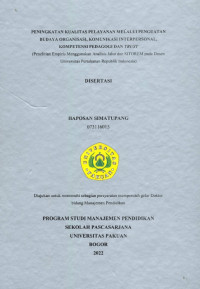Disertasi MP
Peningkatan Kualitas Pelayanan Melalui Penguatan Budaya Organisasi, Komunikasi Pinterpersonal, Kompetensi Pedagogi Dan Truste (Penelitian Empiris Menggunakan Analisis Jalur Dan Sitorem Pada Dosen Universitas Pertahanan Republik Indonesia)
The results of this study conclude that: (1), There is a very significant positive effect between organizational culture (X1) and service quality (Y), with a path coefficient of 0.433 and the equation 1 = 0.2654x + 102.66. (2), there is a very significant positive effect between interpersonal communication (X2) and service quality (Y), with a path coefficient of 0.302 and the equation 2 = 0.2904x + 93,949. (3), there is a very significant positive effect between pedagogical competence (X3) and service quality (Y), with a path coefficient of 0.341 and the equation 3 = 0.8528x + 124.33. (4) There is a very significant positive effect between trust (X4) and service quality (Y), with a path coefficient of 0.341 and the equation 4 = 0.1611x + 112.02. (5), There is a very significant positive effect between organizational culture (X1) and pedagogical competence (X3), with a path coefficient of 0.649 and the equation Y1A = 0.1664 X1 - 6.4132. (6) There is a very significant positive effect between organizational culture (X1) and trust (X4), with a path coefficient of 0.406 and the equation Y1B = 0.430x + 101.52. (7) There is a very significant positive effect between interpersonal communication (X2) and pedagogical competence (X3), with a path coefficient of 0.552 and the equation Y2A = 0.253 X2 - 22.53. (8) There is a very significant positive effect between interpersonal communication (X2) and trust (X4), with a path coefficient of 0.552 and the equation Y2B = 0.515X + 80,673. (9) There is no influence of pedagogical competence on service quality with organizational culture control variable. The results of the analysis show a correlation coefficient of ry11 = 0.087 (10) There is an influence of pedagogical competence on service quality with interpersonal communication control variables. The results of the analysis show a correlation coefficient of ry12 = 0.219 (11) There is no effect of trust on service quality with the control variable of organizational culture. The results of the analysis show a correlation coefficient of ry21 = 0.170 (12) There is an effect of trust on service quality with interpersonal communication control variables. The results of the analysis show a correlation coefficient of ry22 = 0.332 SITOREM analysis in this study was carried out through the stages (1) Contribution Analysis. In Path Analysis research, the strength of the relationship is expressed by the magnitude of the influence (Path Coefficient or Phi) of an independent variable on the dependent variable. The higher the path coefficient, the higher the influence of the independent variable on the variable. (2) Analysis of Research Variable Indicators. Analysis of research results for each research variable indicator is calculated from the average (mean) score of each indicator of each research variable. The average score of each indicator is a description of the actual conditions of these indicators from the point of view of the research subjects. (3) Analysis The weight of each indicator is calculated based on the assessment of one or several experts based on the criteria of "Cost, Benefit, Urgency and Importance" in each indicator to its variable (each variable consists of several indicators), as follows: (a) “Cost” aspect, namely the cost, time, effort, or resources required for the indicator. The higher the "cost" of an indicator, the greater the role of the indicator in a variable, (b) the "Benefit" aspect, namely the benefits, uses, or contributions that the indicator gives to the variable. The higher the "benefit" of an indicator, the greater the role of the indicator in a variable, (c) the "Urgency" aspect, namely how much encouragement, pressure or integrity of an indicator in a variable. The greater the "urgency" of an indicator, the greater the role of the indicator in a variable, (d) the "Importance" aspect, which is how much importance an indicator has in a variable. The higher the level of "importance" of an indicator, the greater the role of the indicator in a variable. (4) Analysis of Determination of Indicator Classification, After obtaining the mean score of the research results on each indicator and the weight (%) of each indicator,
Ketersediaan
Informasi Detail
- Judul Seri
-
-
- No. Panggil
-
33/SIM/D-MP/2022
- Penerbit
- Bogor : SPS Unpak., 2022
- Deskripsi Fisik
-
xvii,367 hlm. : ilus : 29 cm
- Bahasa
-
Indonesia
- ISBN/ISSN
-
-
- Klasifikasi
-
33/SIM/D-MP/2022
- Tipe Isi
-
-
- Tipe Media
-
-
- Tipe Pembawa
-
-
- Edisi
-
-
- Subjek
- Info Detail Spesifik
-
-
- Pernyataan Tanggungjawab
-
Prof. Dr. Sri Setyaningsih, M.Si. Dan Dr. Dian Wulandari, S.Psi, Mba.
Versi lain/terkait
Tidak tersedia versi lain
Lampiran Berkas
Komentar
Anda harus masuk sebelum memberikan komentar

 Karya Umum
Karya Umum  Filsafat
Filsafat  Agama
Agama  Ilmu-ilmu Sosial
Ilmu-ilmu Sosial  Bahasa
Bahasa  Ilmu-ilmu Murni
Ilmu-ilmu Murni  Ilmu-ilmu Terapan
Ilmu-ilmu Terapan  Kesenian, Hiburan, dan Olahraga
Kesenian, Hiburan, dan Olahraga  Kesusastraan
Kesusastraan  Geografi dan Sejarah
Geografi dan Sejarah